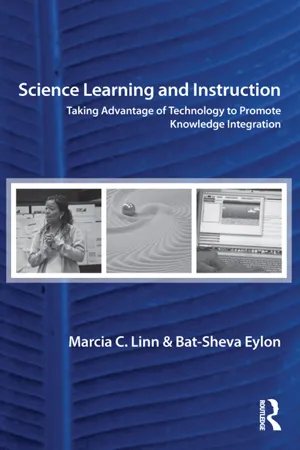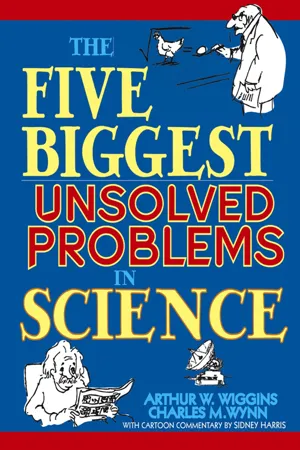Physics
Particle Model of Matter
The Particle Model of Matter is a scientific concept that describes matter as being composed of tiny particles, such as atoms and molecules, which are in constant motion. It explains the behavior of solids, liquids, and gases based on the arrangement and movement of these particles. This model helps to understand and predict the properties and interactions of different forms of matter.
Written by Perlego with AI-assistance
Related key terms
Related key terms
1 of 4
Related key terms
1 of 3
7 Key excerpts on "Particle Model of Matter"
- eBook - ePub
Science Learning and Instruction
Taking Advantage of Technology to Promote Knowledge Integration
- Marcia C. Linn, Bat-Sheva Eylon(Authors)
- 2011(Publication Date)
- Routledge(Publisher)
4
PARTICULATE STRUCTURE OF MATTER
A Case Study
Introduction
In this chapter we discuss a case study of curriculum reform that revealed some promising patterns for high school physical science. The case study involves helping students understand the structure of matter and was conducted by Eylon and her colleagues in Israel (Ben-Zvi, Eylon, & Silberstein, 1986a, 1988; Linn, Songer, & Eylon, 1996; Margel, Eylon, & Scherz, 2008).Structure of Matter
Materials has always been a central topic in junior high school science studies and usually includes the following topics: the particulate nature of matter; states of matter; changes in the state of matter; atoms and molecules; elements, compounds, and mixtures; the structure of the atom; and the relationship between the structure and properties of materials. Many of the traditional curriculum approaches (Dory et al., 1989; Zilag et al., 1980) are based on declarative definitions of the scientific concepts and on confirmatory experiments. In particular, in many textbooks the ideas about the particulate nature of matter are presented as postulates: that matter consists of particles that are too small to be seen; that particles are in intrinsic motion; that there is empty space between the particles. The structure of matter is one of the most fundamental topics in science. A meaningful understanding of this topic is essential for developing a solid basis for further scientific studies. It is revisited in high school chemistry courses but not all students take these courses so middle school physical science is often the first and last time that students encounter this topic. - eBook - ePub
- Hsai-Yang Fang, Ronald C. Chaney(Authors)
- 2016(Publication Date)
- CRC Press(Publisher)
The combination of these three components into one system is called the particle energy field. Basically, the theory combines the concepts of mechanics, solid-state physics, and chemistry on one side; physicochemical, organic chemistry, and biology on the other side. Interacting between these two groups is the common denominator known as the particle. Particles are the fundamental building units of all types of materials, including soil, water, gas (air), and pollutants. In addition, some environmental phenomena such as ion-exchange reaction, adsorption, redox reaction, and soil-bacteria interaction that pose difficulties in the current geotechnical approach are incorporated in this theory. The theory is based on the following assumptions.2.2.2 ASSUMPTIONS- The physical world is constructed of elementary particles such as atoms, ions, and molecules.
- These elementary particles may attract or repel each other.
- Bonding energies such as ionic, covalent, and chemical and linkage such as cation, water dipole, and dipole–cation control the stress-strain-strength and durability between particles.
- The relative movement of particles is caused by these energies.
- Particle systems can be
• Solid state if attraction (A) ≫ repulsion (R) • Liquid state if attraction (A) ≈ repulsion (R) • Gaseous state if attraction (A) ≪ repulsion (R)
2.2.3 ELEMENTARY PARTICLESElements are composed of tiny, fundamental particles of matter called atoms . Ordinary atoms are neutral, i.e., they do not carry an electrical charge. However, under certain circumstances, atoms can become electrically charged. Such charged atoms are called ions . Some elements form positive ions, called cations , and some form negative ions, called anions .The atom as a basic particle of matter is composed of still smaller particles called subatomic particles. The neutron, electron, and proton are classified as subatomic particles. The positive subatomic particle present in the atom is called a proton . Units of negative charges are known as electrons . A third subatomic particle found as a constituent of atoms that carries no electrical charge (neutral) is known as the neutron .The sharing of a pair of electrons binds the atoms together to form a new kind of particle called a molecule . Molecules are stable particles and are characteristically chemical particles of many compounds. A summary of basic types of particles that serve as building units of matter is presented in Table 2.1 - eBook - ePub
- R. Campbell(Author)
- 2015(Publication Date)
- Palgrave Macmillan(Publisher)
What continued to be called ‘atoms’ were now divided into even smaller sub-atomic entities: electrons, protons, and neutrons – enabling at last explanations of chemical changes, including combustion. Through these developments, the idea that certain changes might be explained in terms of specific kinds of matter lost its appeal. In the light of the radical shifts in physical theory beginning early in the 20th century, it has become clear that there is no single kind of stuff out of which everything is constituted. Nevertheless, the words “matter” and its cognate “material” have become entrenched in both everyday and philosophical discourse. Those who continue to use these words seem to mean something like an indefinite stuff from which everything in the world is constituted. Hence the persistence of talk about ‘basic bits of matter’. But that is incredibly vague, as well as being at variance with how physicists now use the word. One somewhat less vague meaning commonly attributed to ‘matter’ nowadays is anything that has both mass and volume. But the most recent developments in sub-atomic physics have shown that definition to be quite inadequate too. To anticipate our later discussion, atoms and molecules, for example, contain an energy generated by their interaction which holds the constituents together. However, on the Standard Model of Quantum Field Theory, protons and neutrons are themselves made up of quarks bound together by gluon fields and these gluons fields contribute significantly to the mass of hadrons, which are composite ‘particles’ containing either a quark and an anti-quark (mesons) or three quarks (baryons) (Aitchison & Hey 2004, 48). To a great extent, the mass of an atom is simply the sum of the masses of its constituent protons, neutrons, and electrons, but their mass in turn is due to the binding energy of quarks within the protons and neutrons (the generation of mass is thought to be the role of the recently confirmed Higgs boson) - eBook - ePub
- Allan F.M. Barton(Author)
- 2021(Publication Date)
- CRC Press(Publisher)
An atom contains a minute and extremely dense ‘nucleus’, made up of particles called ‘protons’, each with one positive charge, as well as uncharged particles called ‘neutrons’. ‘Electrons’ occupy most of the space of each atom, each electron having one negative charge. The protons and neutrons are of nearly equal mass 12 and the electrons are very much lighter 13. The abilities of atoms to combine in the form of molecules, which in turn aggregate to form bulk materials, depend mainly on the ‘outer’ or ‘bonding’ electrons of atoms. So do the properties of these materials. These electrons are those least strongly held to a nucleus, and the ones most likely to interact with electrons from other atoms to form ‘chemical bonds’. Physicists have shown that protons, neutrons and electrons are not the fundamental elementary constituents of matter as previously believed. Although this is unimportant for some uses of the models (in some aspects of chemistry, for example), a better understanding of materials is possible if we explore more detailed models. The model now widely used in physics incorporates more fundamental matter particles, including ‘quarks’ 14. We must also consider how these particles interact. To do this we include in our model the ideas of ‘force’ and ‘interactions’, as well as ‘force-carrying particles’ such as the ‘photon’, which is the smallest ‘particle’ of light. As well as the atom, we also owe to the early Greek modellers the idea of dividing the Universe up into ‘matter’ and ‘forces’. ‘Gravitation’ acted on two of the four basic elements making up matter in their model, ‘earth’ and ‘water’, causing them to sink. The elements ‘air’ and ‘fire’ experienced ‘levity’, the tendency to rise. This distinction between matter and force has clearly been an extremely useful model for succeeding generations of scientists trying to understand how the Universe works. It has been just as important in appreciating the structure of matter as in exploring the galaxies - eBook - ePub
- Arthur W. Wiggins, Charles M. Wynn(Authors)
- 2008(Publication Date)
- Trade Paper Press(Publisher)
CHAPTER TWOPHYSICS
Why Do Some Particles Have Mass while Others Have None?
The baby figure of the giant mass Of things to come at large.—William Shakespeare ,Troilus and CressidaPhysics is the study of the properties of matter at rest and in motion and of various forms of energy. Motion-related properties such as velocity, acceleration, and momentum are well understood, as are kinetic and potential energy. What is not understood is the nature of mass, a property of most forms of matter. In fact, the origin of mass is currently the biggest unsolved problem in physics.Mass
We are all too familiar with the fact that mass exists. Mass is self-evident. We all seem to have too much or too little of it. Mass is what makes it harder to push a stalled car than a baby carriage. Mass is what gravity tugs on to keep us grounded on planet Earth.What is not at all clear is the origin of mass. Many, but not all, of the fundamental particles in the universe have mass. Why do some have mass, while others have none? What “gives” mass to some particles and not others? Among particles with mass, why do some have more mass than others? Do particles without mass lack something else besides mass? The answers to these questions may lie in something called the Higgs field, but we’ll need some background information before we can make sense of the elusive Higgs field.To begin with, we know that a body’s mass is related to the amount of matter it contains, and we have a pretty good idea of what forms matter: collections and combinations of atoms. But what forms the atoms? Atoms are composed of electrons, protons, and neutrons. But what forms the electrons, protons, and neutrons? Electrons are fundamental (not composed of “anything else”), but protons and neutrons are not. They are made of quarks, and it is quarks and electrons that appear to be truly fundamental.Before we can discuss the unsolved nature of mass, we’ve got to see where quarks came from. (See Figure 2.1.) In the process, we’ll run across a few other fundamental particles, we’ll see that fields are regarded as even more fundamental than particles, and we’ll investigate physics’ best field theory, called the Standard Model. Next we’ll note the inadequacies of the Standard Model: It doesn’t identify the source of mass, and it omits gravity entirely. Finally, we’ll explore theories beyond the Standard Model that would solve the problem about mass’s origins. - eBook - ePub
Developments in Surface Contamination and Cleaning, Vol. 1
Fundamentals and Applied Aspects
- Rajiv Kohli, Kashmiri L. Mittal(Authors)
- 2015(Publication Date)
- William Andrew(Publisher)
A particle in the size range below about 5 nm comprises a relatively small number of molecules. So it is no longer appropriate to think of the particle as an entity which exhibits the properties of the bulk material from which it is derived. Now we cannot speak of it in terms of a volume or a surface which derives from the assumption that the structure of the particle is a continuum. As has been stated more than once, the nature of the particle, unlike for large particles, cannot be regarded as that of either the liquid or the solid state. The nanoparticle is therefore a molecular cluster which must be regarded as an entirely distinct phase of matter, the nanophase. In this phase, the character of the particle is governed by the properties of the individual atoms and molecules: their configuration, their individual, combined, and mutually influenced electronic states. Therefore, considerations of particle behavior and the way the particle interacts with other entities must be based on both quantum mechanics and classical kinetic theory.The dynamic properties of the nanophase are extremely important. Nanoparticles are formed in very large numbers during nucleation. But coagulation of such particles occurs very rapidly even at very low mass concentrations. So the lifetime of such particles under normal conditions is very short. This in turn imposes constraints on the kinetics of how such particles interact with other entities—physically, chemically, or biologically.Currently, only simple interactions are well understood. But we are now beginning to anticipate significant scientific advances based on the very special nature of nanoparticles. It is expected that during the years ahead, kinetic theory, quantum mechanics, and aerosol dynamics, together with applications arising from advancing knowledge of these fundamental disciplines, will enable us to predict the interactions in much more complicated systems. Such basic understanding of the different molecular configurations, their orientation, their Brownian rotation, and their chemical interactions will change our perception of atmospheric and gas chemistry. This will also force us to think about new approaches in the development of chemical reactors toward the production of new and more advanced materials.One particularly important aspect of small particles is the way in which they might interact with cells in biological systems. In relation to air pollution, for example, there is increasing concern about the role of small atmospheric particles in the observed increases in disease and mortality in the human populations (e.g. Seaton et al.20 ). In this regard, it seems relevant that Donaldson et al.6 have demonstrated in vitro - Dieter Straub, William F. Ames(Authors)
- 1996(Publication Date)
- Academic Press(Publisher)
Observing artificial but well-posed test conditions, the matter model, derived from Einstein’s mechanics, strictly speaking is constitutive for modem particle physics. However, with regard to macroscopic phenomena this matter model is questionable in view of realistic matter and field concepts for volume elements of a macroscopic continuum theory.However, the theory of pseudo-particles shows the necessity of finding a connection between v and P that is also parametrically dependent on all other variables of the system, as displayed in the V -Legendre-transformed Gibbs–Euler function. In this case, additional differential equations appear to resemble Falk’s equations (3.39) . They prevent the balances for linear momentum and internal energy from being separately established with regard to an accurate representation of the complete (nonrelativistic) continuum theory of compressible fluids.In addition, the basic problem of formulating a mathematical description of macroscopic phenomena by means of a finite number of empirical data leads to an amazing solution: It can be proven for a highly representative system distinguished by a well-known M–G function and a reliable data base that the atomic structure of macroscopic systems offers an option to avoid metaphysical results.This statement is not trivial: The atomic structure refers to a finite number of particles to be defined thermodynamically with the help of an elementary amount of moles u involved. These thermodynamic particles cannot be imagined as a swarm of mechanical particles moving discriminately. Although relations exist between the properties and, particularly, the notations of the two sorts of particles (Falk, 1990 , p. 339), we cannot extrapolate them to real gases or other nonidealized substances like liquids. For this reason, considerations triggered by purely mechanical imaginations seem to be misplaced in face of a consequent mathematical theory of non-equilibrium phenomena. This is especially true for mass-point physics manifested by the alleged identity (3.9) of specific momentum and flow velocity of a fluid element with mass m.
Index pages curate the most relevant extracts from our library of academic textbooks. They’ve been created using an in-house natural language model (NLM), each adding context and meaning to key research topics.
Explore more topic indexes
Explore more topic indexes
1 of 6
Explore more topic indexes
1 of 4






